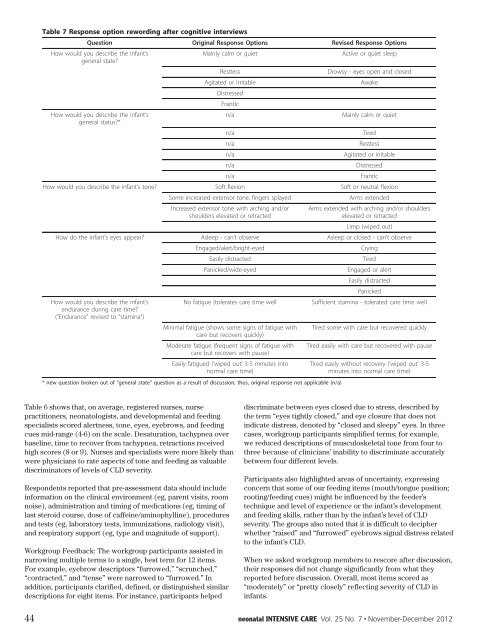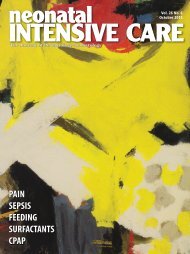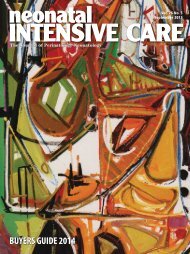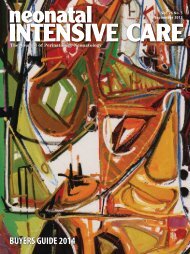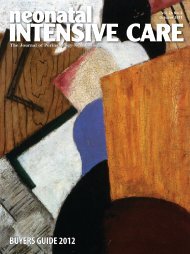You also want an ePaper? Increase the reach of your titles
YUMPU automatically turns print PDFs into web optimized ePapers that Google loves.
Table 7 Response option rewording after cognitive interviews<br />
Question Original Response Options Revised Response Options<br />
How would you describe the infant’s<br />
general state?<br />
How would you describe the infant’s<br />
general status?*<br />
Table 6 Each shows instrument that, on average, development registered phase nurses, could nurse not alone<br />
practitioners, lead to aneonatologists, successful product, and developmental but no phaseand wasfeeding dispensa-<br />
specialists ble, and, scored taken alertness, together, tone, they eyes, have eyebrows, generated and feeding a set of<br />
cues mid-range items ready (4-6) for on quantitative the s<strong>ca</strong>le. Desaturation, assessment. tachypnea Our develop- over<br />
baseline, ment time process to recover is limited from tachypnea, by the fact retractions that it is received performed<br />
high scores<br />
only in<br />
(8<br />
a<strong>ca</strong>demic<br />
or 9). Nurses<br />
medi<strong>ca</strong>l<br />
and specialists<br />
centers, although<br />
were more<br />
it<br />
likely<br />
is reason-<br />
than<br />
were physicians to rate aspects of tone and feeding as valuable<br />
able to assume that most non-a<strong>ca</strong>demic center neonatal<br />
discriminators of levels of CLD severity.<br />
intensive <strong>ca</strong>re units would share many features of the<br />
Respondents<br />
a<strong>ca</strong>demic<br />
reported<br />
medi<strong>ca</strong>l<br />
that<br />
center<br />
pre-assessment<br />
environment.<br />
data<br />
Our<br />
should<br />
focus<br />
include<br />
groups<br />
information were conducted on the clini<strong>ca</strong>l at environment only two neonatal (eg, parent intensive visits, room <strong>ca</strong>re<br />
noise), units administration both lo<strong>ca</strong>ted and intiming a single of medi<strong>ca</strong>tions state, opening (eg, the timing possibi- of<br />
last steroid lity ofcourse, limitations dose of by<strong>ca</strong>ffeine/aminophylline), region, or practice culture. procedures Our<br />
and tests more (eg, geographi<strong>ca</strong>lly laboratory tests, dispersed immunizations, cognitive radiology interviewing visit),<br />
and respiratory and field support testing (eg, should type and help magnitude us identify of support). any such<br />
problems.<br />
Workgroup Feedback: The workgroup participants assisted in<br />
narrowing multiple terms to a single, best term for 12 items.<br />
For example, eyebrow descriptors “furrowed,” “scrunched,”<br />
“contracted,” and “tense” were narrowed to “furrowed.” In<br />
addition, participants clarified, defined, or distinguished similar<br />
descriptions for eight items. For instance, participants helped<br />
Mainly <strong>ca</strong>lm or quiet Active or quiet sleep<br />
Restless Drowsy - eyes open and closed<br />
Agitated or irritable Awake<br />
Distressed<br />
Frantic<br />
n/a Mainly <strong>ca</strong>lm or quiet<br />
n/a Tired<br />
n/a Restless<br />
n/a Agitated or irritable<br />
n/a Distressed<br />
n/a Frantic<br />
How would you describe the infant’s tone? Soft flexion Soft or neutral flexion<br />
Some increased extensor tone, fingers splayed Arms extended<br />
Increased extensor tone with arching and/or<br />
shoulders elevated or retracted<br />
Arms extended with arching and/or shoulders<br />
elevated or retracted<br />
Limp (wiped out)<br />
How do the infant’s eyes appear? Asleep - <strong>ca</strong>n’t observe Asleep or closed - <strong>ca</strong>n’t observe<br />
How would you describe the infant’s<br />
endurance during <strong>ca</strong>re time?<br />
("Endurance” revised to “stamina”)<br />
Engaged/alert/bright-eyed Crying<br />
Easily distracted Tired<br />
Panicked/wide-eyed Engaged or alert<br />
Easily distracted<br />
Panicked<br />
No fatigue (tolerates <strong>ca</strong>re time well Sufficient stamina - tolerated <strong>ca</strong>re time well<br />
Minimal fatigue (shows some signs of fatigue with<br />
<strong>ca</strong>re but recovers quickly)<br />
Moderate fatigue (frequent signs of fatigue with<br />
<strong>ca</strong>re but recovers with pause)<br />
Easily fatigued (’wiped out’ 3-5 minutes into<br />
normal <strong>ca</strong>re time)<br />
* new question broken out of “general state” question as a result of discussion, thus, original response not appli<strong>ca</strong>ble (n/a)<br />
Tired some with <strong>ca</strong>re but recovered quickly<br />
Tired easily with <strong>ca</strong>re but recovered with pause<br />
Tired easily without recovery (’wiped out’ 3-5<br />
minutes into normal <strong>ca</strong>re time)<br />
discriminate The PRPOS between is currently eyes closed undergoing due to stress, fielddescribed testing at by<br />
the fiveterm a<strong>ca</strong>demic “eyes tightly medi<strong>ca</strong>l closed,” centers, and where eye closure bedside that nurses does not are<br />
indi<strong>ca</strong>te applying distress, the assessment denoted by tool “closed to and a cohort sleepy” ofeyes. 150-200 In three<br />
<strong>ca</strong>ses, neonates workgroup (25-40 participants per institution) simplified between terms; 23for and example, 30-6<br />
we weeks reduced gestational descriptions age at of musculoskeletal birth (excluding tone infants from with four to<br />
three<br />
chromosomal<br />
be<strong>ca</strong>use of<br />
abnormalities)<br />
clinicians’ inability<br />
and between<br />
to discriminate<br />
36-0 and<br />
accurately<br />
36-6<br />
between four different levels.<br />
weeks postmenstrual age. At the conclusion of field testing,<br />
we will perform psychometric analyses of the data<br />
Participants also highlighted areas of uncertainty, expressing<br />
concern<br />
to test item<br />
that some<br />
validity<br />
of our<br />
and<br />
feeding<br />
reliability,<br />
items<br />
for<br />
(mouth/tongue<br />
the purpose<br />
position;<br />
of<br />
rooting/feeding further s<strong>ca</strong>le refinement. cues) might be influenced by the feeder’s<br />
technique and level of experience or the infant’s development<br />
and Conclusions feeding skills, rather than by the infant’s level of CLD<br />
severity. We expect The that groups usealso of the noted PRPOS that it to is difficult assess observable, to decipher<br />
whether functional “raised” domains and will “furrowed” greatly eyebrows enhance the signal current distress unirelated<br />
to dimensional the infant’s CLD. assessment of BPD severity based on<br />
When we asked workgroup members to rescore after discussion,<br />
their responses did not change signifi<strong>ca</strong>ntly from what they<br />
reported before discussion. Overall, most items scored as<br />
“moderately” or “pretty closely” reflecting severity of CLD in<br />
infants.<br />
44 neonatal INTENSIVE CARE Vol. 25 No. 7 n <strong>Nov</strong>ember-<strong>Dec</strong>ember <strong>2012</strong>


